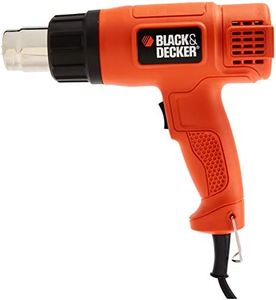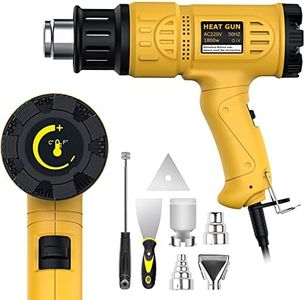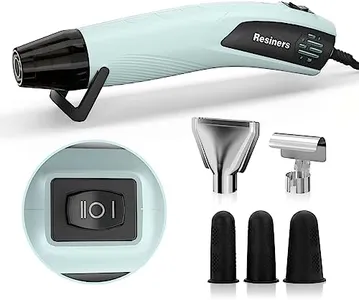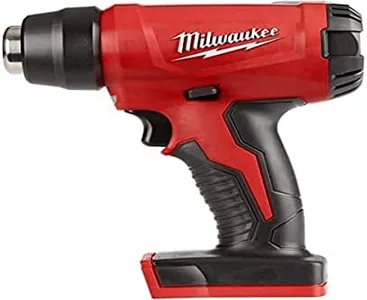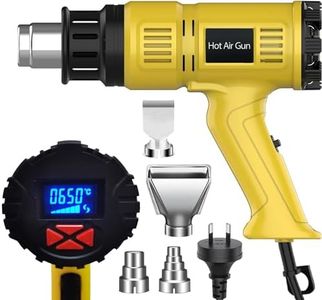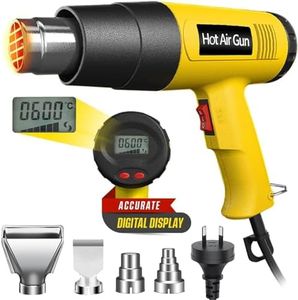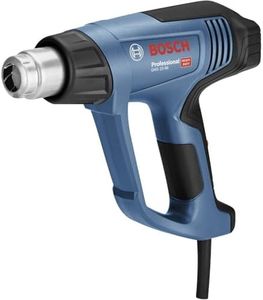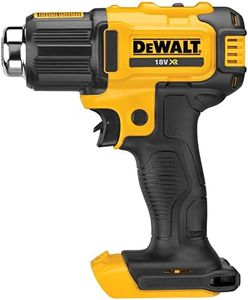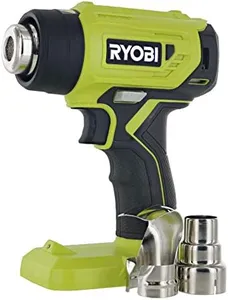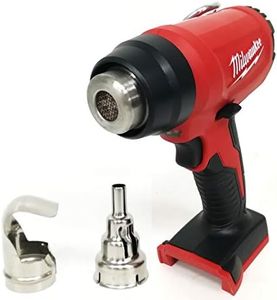We Use CookiesWe use cookies to enhance the security, performance,
functionality and for analytical and promotional activities. By continuing to browse this site you
are agreeing to our privacy policy
10 Best Heat Guns
From leading brands and best sellers available on the web.Buying Guide for the Best Heat Guns
Choosing the right heat gun depends on what you want to use it for, because heat guns come in different sizes, power levels, and with a range of features. Before you buy, think about the types of projects you plan to tackle—such as paint removal, shrinking wrap, thawing pipes, or crafting—and how often you expect to use the tool. Understanding the key specifications will help you find a heat gun that is safe, efficient, and perfectly suited to your needs.Temperature RangeTemperature range tells you how hot the heat gun can get, usually given in degrees Celsius or Fahrenheit. This spec is important because different tasks require different levels of heat: light crafting or delicate jobs need lower temperatures, while stripping paint or loosening bolts require much higher heat. Basic models might provide a fixed setting around 500°F (260°C), while advanced heat guns offer variable ranges, sometimes from as low as 120°F (50°C) up to 1200°F (650°C) or more. If you only need the tool for occasional home fixes, a low to moderate temperature range should be enough. For advanced or frequent uses, especially for professional tasks, look for a heat gun that offers a wide and adjustable range so you can handle more projects safely and effectively.
Air Flow (CFM)Air flow, often measured in cubic feet per minute (CFM), shows how much air the gun moves over the heating element every minute. Air flow is important twofold: it influences how quickly the gun heats up surfaces and affects the precision of the work. Lower air flow is better for smaller, precise jobs like electronics or crafts, whereas higher air flow helps when you need to cover larger areas or work quickly, like paint removal. If you plan to do a mix of tasks, look for a heat gun with adjustable air flow, or choose a model based on whether you expect to work with fine details or broad surfaces.
Temperature ControlTemperature control refers to how you set the heat level—some guns have just two or three preset settings (like low, medium, high), while others allow you to dial in the specific temperature you want. This is important for versatility and safety because projects often demand different heat levels, and sensitive materials can be damaged by too much heat. If you only plan to do one kind of task, a simple on/off or preset gun works fine. If you want flexibility, especially for crafts, electronics, or working with various materials, opt for a model that lets you fine-tune the temperature.
Nozzle AttachmentsNozzle attachments are optional tips you can fit on the end of the heat gun to direct or spread the heat. These accessories are important because they make the tool more versatile—different jobs might need a concentrated stream of heat, a wide area of hot air, or protection for surrounding surfaces. When picking a heat gun, check what nozzles are included or available: wide nozzles are good for paint stripping, while reduction or reflector nozzles help with plumbing, soldering, or crafts. Choose a heat gun that comes with attachments tailored to the tasks you plan, or find a model compatible with add-ons you can buy later.
Safety FeaturesSafety features on heat guns protect both you and your work. Look for things like automatic shut-off, cool-down modes, thermal cut-out (which prevents overheating), and stable standing support so you can put the tool down safely while it's still hot. Safety is especially important for beginners or anyone working in busy or cluttered spaces. Pick a heat gun with features that match your comfort level and the environments where you'll use the tool most often.
Ergonomics and WeightErgonomics describes how comfortable and easy the heat gun is to hold and use, while weight affects how long you can work without fatigue. Heavier and bulkier models can be difficult to maneuver for long periods, especially on vertical surfaces or detailed tasks, while light, well-balanced guns reduce strain on your hands and arms. If you expect to use the heat gun often or for big projects, choose a model that feels comfortable and easy to control; try to handle a few before you buy, if possible.
